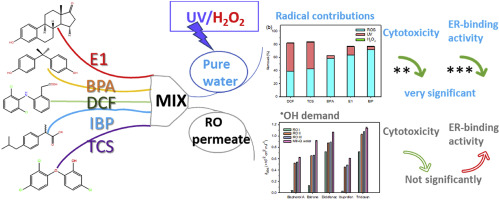当前位置:
X-MOL 学术
›
Water Res.
›
论文详情
Our official English website, www.x-mol.net, welcomes your
feedback! (Note: you will need to create a separate account there.)
Degradation of contaminants of emerging concern by UV/H2O2 for water reuse: Kinetics, mechanisms, and cytotoxicity analysis.
Water Research ( IF 11.4 ) Pub Date : 2020-02-04 , DOI: 10.1016/j.watres.2020.115587 Ying Huang 1 , Minghao Kong 2 , Scott Coffin 3 , Kristin H Cochran 4 , Danielle C Westerman 4 , Daniel Schlenk 5 , Susan D Richardson 4 , Lecheng Lei 6 , Dionysios D Dionysiou 2
Water Research ( IF 11.4 ) Pub Date : 2020-02-04 , DOI: 10.1016/j.watres.2020.115587 Ying Huang 1 , Minghao Kong 2 , Scott Coffin 3 , Kristin H Cochran 4 , Danielle C Westerman 4 , Daniel Schlenk 5 , Susan D Richardson 4 , Lecheng Lei 6 , Dionysios D Dionysiou 2
Affiliation

|
Advanced oxidation using UV and hydrogen peroxide (UV/H2O2) has been widely applied to degrade contaminants of emerging concern (CECs) in wastewater for water reuse. This study investigated the degradation kinetics of mixed CECs by UV/H2O2 under variable H2O2 doses, including bisphenol A, estrone, diclofenac, ibuprofen, and triclosan. Reverse osmosis (RO) treated water samples from Orange County Water District's Groundwater Replenishment System (GWRS) potable reuse project were collected on different dates and utilized as reaction matrices with spiked additions of chemicals (CECs and H2O2) to assess the application of UV/H2O2. Possible degradation pathways of selected CECs were proposed based on high resolution mass spectrometry identification of transformation products (TPs). Toxicity assessments included cytotoxicity, aryl hydrocarbon receptor-binding activity, and estrogen receptor-binding activity, in order to evaluate potential environmental impacts resulting from CEC degradation by UV/H2O2. Cytotoxicity and estrogenic activity were significantly reduced during the degradation of mixed CECs in Milli-Q water by UV/H2O2 with high UV fluence (3200 mJ cm-2). However, in GWRS RO-treated water samples collected in April 2017, the cytotoxicity and estrogen activity of spiked CEC-mixture after UV/H2O2 treatment were not significantly eliminated; this might be due to the high concentration of target CEC and their TPs, which was possibly affected by the varied quality of the secondary treatment influent at this facility such as sewer-shed and wastewater discharges. This study aimed to provide insight on the impacts of post-UV/H2O2 CECs and TPs on human and ecological health at cellular level.
中文翻译:

UV / H2O2降解令人关注的污染物用于水的再利用:动力学,机理和细胞毒性分析。
使用紫外线和过氧化氢(UV / H2O2)进行的高级氧化已广泛应用于降解废水中的新出现的污染物(CEC),以用于水的再利用。这项研究研究了在可变H2O2剂量下,包括双酚A,雌酮,双氯芬酸,布洛芬和三氯生,UV / H2O2对混合CECs的降解动力学。在不同日期收集了奥兰治县水区地下水补充系统(GWRS)饮用水回用项目的反渗透(RO)处理过的水样品,并将其用作添加了化学品(CEC和H2O2)的加标反应矩阵,以评估UV / H2O2的应用。基于高分辨率质谱法对转化产物(TPs)的鉴定,提出了某些CECs可能的降解途径。毒性评估包括细胞毒性,芳基烃受体结合活性和雌激素受体结合活性,以评估由于CEC被UV / H2O2降解而引起的潜在环境影响。在具有高紫外线通量(3200 mJ cm-2)的UV / H2O2降解Milli-Q水中混合CEC的过程中,细胞毒性和雌激素活性显着降低。然而,在2017年4月收集的经GWRS RO处理的水样本中,未明显消除加标CEC混合物在UV / H2O2处理后的细胞毒性和雌激素活性; 这可能是由于目标CEC及其TP的浓度很高,而这可能受到该工厂二级污水的质量变化的影响,例如下水道和废水排放。
更新日期:2020-02-04
中文翻译:

UV / H2O2降解令人关注的污染物用于水的再利用:动力学,机理和细胞毒性分析。
使用紫外线和过氧化氢(UV / H2O2)进行的高级氧化已广泛应用于降解废水中的新出现的污染物(CEC),以用于水的再利用。这项研究研究了在可变H2O2剂量下,包括双酚A,雌酮,双氯芬酸,布洛芬和三氯生,UV / H2O2对混合CECs的降解动力学。在不同日期收集了奥兰治县水区地下水补充系统(GWRS)饮用水回用项目的反渗透(RO)处理过的水样品,并将其用作添加了化学品(CEC和H2O2)的加标反应矩阵,以评估UV / H2O2的应用。基于高分辨率质谱法对转化产物(TPs)的鉴定,提出了某些CECs可能的降解途径。毒性评估包括细胞毒性,芳基烃受体结合活性和雌激素受体结合活性,以评估由于CEC被UV / H2O2降解而引起的潜在环境影响。在具有高紫外线通量(3200 mJ cm-2)的UV / H2O2降解Milli-Q水中混合CEC的过程中,细胞毒性和雌激素活性显着降低。然而,在2017年4月收集的经GWRS RO处理的水样本中,未明显消除加标CEC混合物在UV / H2O2处理后的细胞毒性和雌激素活性; 这可能是由于目标CEC及其TP的浓度很高,而这可能受到该工厂二级污水的质量变化的影响,例如下水道和废水排放。











































 京公网安备 11010802027423号
京公网安备 11010802027423号